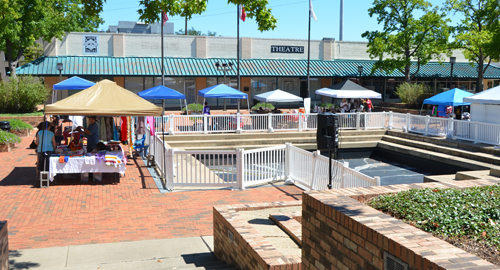Garland City Council members will likely vote on whether to demolish the historic buildings on the east side of the square after a March 21 public hearing during which opponents of demolition will have a chance to make alternate proposals.
Those in favor of a March 21 vote outnumbered Mayor Doug Athas, who pushed for delaying the vote until April 1, until the city could obtain design proposals from interested parties in the city’s request for proposal process. Council Member Jim Cahill was the lone other council member that said he was willing to wait.
The square’s east side, with the earliest portion built in 1906, is often called the “Crossman Block” because of the Curtis Crossman family that operated an insurance business there.
Council Members Anita Goebel and Lori Barnett Dodson said they were willing to demolish the building immediately without further deliberation.
“If we can do it tonight, I’m for it,” said Goebel.
Council Members Stephen Stanley, David Gibbons, Rich Aubin and B.J. Williams and Mayor Pro Tem Scott LeMay favored the March 21 date.
Gibbons and Aubin expressed concern that the Feb. 23 public meeting didn’t include an opportunity for attendees to speak publicly or hear one another’s opinions. Attendees could complete a response sheet and speak to city staff, but the format was not designed for public input.
Stanley said the March 21 hearing would be a time to “bring forth your best ideas and best arguments.” Aubin said it would represent the “last, best chance” for those with alternate proposals to come forth.
Athas argued for the April 1 date because an earlier decision wouldn’t allow time for responses to the RFP to be received. In Athas’ plan the proposals would be presented and a hearing held.
“If there were folks that were truly interested, they would have been here with their proposals already,” Dodson said.
LeMay said a delay could force an entire restart because there will soon be three new council members. Dodson and Cahill are not eligible for re-election in May and Stanley has chosen not to seek another term.
“We’re not moving forward…,” LeMay said. “We have exhausted the discussion phase.”
Athas proposed historic reconstruction utilizing some of the building’s architectural features, such as the 100-year-old tin ceilings and original walls. He contends that portions of the building can be salvaged and repurposed.
The city’s application for listing on the National Register of Historic Places, once finalized in about five weeks, would set in motion the ability of building owners involved in historic restoration to utilize the 45 percent tax credits (combined state and federal) that will be available to contributing resources in the area, such as the East Side building. The city’s nomination is with the National Parks Service awaiting approval. The NPS has 45 days to act on the application which arrived in Washington, D.C, about 10 days ago.
If council votes in two weeks to demolish the Crossman building, it theoretically could be bulldozed before the NPS makes its final determination on the National Register status of the downtown square.
Goebel cited preservation architect Nancy McCoy, the city’s consultant, as saying that “it would make no difference if that building was demolished.”
However, when Garland’s Travis College Hill Historic District, the city’s first site listed on the National Register, was going through the approval process, the Texas Historical Commission’s office declined to list its east side of the 300 block of South11th Street, where in the 1990s four historic homes had been demolished.
Assistant City Manager Rick Vasquez said 16 downtown property and business owners (represented by 10 people) attended a stakeholder’s meeting and indicated they were in favor of demolition.
He said that at the Feb. 23 meeting, the estimated 60 attendees were asked to submit response forms indicating their choice of square designs plus their opinions on demolition versus leaving the building standing. Vasquez said 30 responses were submitted, some from couples. He said Design D, the more open plan, was favored in a 70/30 split, with a preponderance also favoring removing the building. The response forms were not official ballots and were lying on tables for attendees to complete.
Vasquez said that delaying the decision “sends a message to prospective tenants in downtown that we don’t have a clear vision for downtown.”
“We think we already have all the information we need,” he said.
He added that the city has already spent about $600,000 on consultants studying the future of the square.
Dodson said the type and draw of a business is far more important than the building itself.
Athas said rushing into demolition or a flawed plan would again be “something you have to live with for (another) 40 years.”


